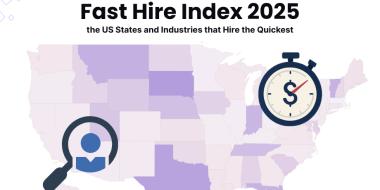Understanding the concept of an infographic resume
An infographic resume provides a visual representation of your professional qualifications. Instead of requiring a hiring manager to read through your entire job history, this type of resume highlights your skills in a way that captivates attention and makes the information easy to digest. Learn whether you should use this type of resume for your job search and how to craft one for maximum appeal.

When an infographic resume is useful
An infographic resume (also referred to as a visual resume) is an appealing option for many job search candidates because it allows them to show their creativity and stand out in a competitive job market.
Not all job seekers know about or desire to use this visually engaging format, so it can definitely make your resume more memorable for a hiring manager. Still, it’s important to understand the situations in which it may be most useful.
If the hiring manager or job description requests an infographic resume, then you should definitely use one, as not following directions can put your application in jeopardy. You may also choose to use one if you’re applying for a job in a more creative field (such as graphic design) or if you know the employer welcomes creativity as part of the workplace culture.
It can also be helpful to include an infographic resume as part of your creative portfolio if you’re submitting one.
Key components of an infographic resume
While infographic resumes are frequently thought of as special, they still need to include the typical information most resume articles suggest. Here are some of the elements you should include, as well as a few suggestions for how to incorporate visuals such as charts, graphs, icons, and timelines.
Summary
The summary portion of your infographic resume should be at the top. You can definitely use words to tell the story of your professional trajectory and highlight your skills. However, you can also use icons and charts to demonstrate concepts like the number of years you have under your belt, the type of roles you’ve held, and the skills you’ve gained.
Work experience
This section highlights the relevant jobs you have had in the past. In an infographic resume, you can present this section like a timeline that indicates how long you’ve held each position and what you were responsible for in each one. You can also just present each job like you would on a traditional resume and use an icon to highlight the section or to delineate each previous position.
Skills
The skills section of your infographic resume should list both the technical and soft skills you’ve garnered in your field. Some use a star rating or bar chart to indicate how proficient they are in each area. Others use word clouds or bubbles of varying sizes to indicate their proficiency level in each skill.
Education
Your education section should clearly explain any coursework completed or degrees earned after high school. This includes any special certifications you have pursued. You can use special icons (such as a graduation hat or school logos) to delineate schools and degrees or include software icons to indicate any software-specific training or certification.
Contact information
You must include contact information if you want the hiring manager to respond to you. Many people customize their visual resume template using icons for each form of contact, such as the LinkedIn logo next to the profile URL, a location pin icon next to address information, an envelope icon next to an email address, or a Wi-Fi icon next to a website URL.
Expert tip:
Design principles for an effective infographic resume
Infographic resumes are meant to showcase your creativity and help you stand out. However, you want to make sure you stand out in a good way. To make it easy for hiring managers to understand and follow your creative resume, make sure to incorporate the following design principles.
Simplicity
Consider taking a minimalist approach when crafting your infographic resume. Having enough white space ensures that your words or visual elements don’t overcrowd the page or obscure essential information. This allows the hiring manager to enjoy your presentation and understand what you have to offer.
Visual hierarchy
Visual hierarchies are another tool you can use to help others easily navigate a graphic resume. This simply refers to the strategic use of font sizes, styles, and spacing. For example, you can delineate headings with a larger font size or indicate important details with bold lettering.
Creating your own infographic resume
You should prioritize creativity when crafting your own infographic resume. Though you can hand-draw your resume, using a software tool can be much easier. This ensures it comes across as polished and professional and can make it easier to incorporate charts, icons, and other visual elements.
Some of the most popular software platforms for creating visual resumes include:
- Canva: This software makes it easy to create an infographic resume by providing resume and cover letter templates and a streamlined, drag-and-drop interface
- Adobe Illustrator: This advanced vector graphics editor and design software allows you to create your own images from scratch or use existing images as a guide
- Piktochart: This software functions as a dedicated infographic maker and integrates with other software platforms to translate data into visual charts and graphs
As you create your resume, keep the following practical tips in mind:
- Choose a cohesive and professional color scheme
- Stick to basic fonts and avoid overly stylized options
- Create well-defined labeled sections to help with navigation
- Use the same fonts, color scheme, bullet points, and icon styles throughout to avoid confusion
These tools and tips can provide you with what you need to create a stylish and professional infographic resume and cover letter that gets results.
"While infographic resumes are frequently thought of as special, they still need to include the typical information most resume articles suggest."
Showcasing your infographic resume
Whether you created your infographic resume from scratch or used visual resume examples, you’ll want to make sure someone sees it. This helps you get your resume noticed so you can land your next role. However, sending it directly to a hiring manager isn’t the only way to achieve this goal.
If you have an online portfolio that showcases your past work, make sure to upload your infographic resume on that website as well.
This allows you to simply send potential employers a link without having to include any additional documents. It also ensures that hiring managers who stumble upon your website have all the information they need about your background and qualifications to decide whether they’d like to take the next step and contact you.
Additionally, remember to share your infographic resume on professional networking platforms like LinkedIn, Twitter, and Instagram. Your visual resume, along with the strategic use of hashtags, keywords, and connections, can help you set yourself apart on these platforms and attract attention from hiring managers and recruiters.
Create an infographic resume that positions you for success
Infographic resumes are a great way to showcase your creativity and stand out from many other applicants. However, they must be done right. As you work on your resume, don’t neglect key components like the summary, education, work experience, and skills sections, as hiring managers will still be looking for that information.
Also, make sure that you know and use basic design principles, such as leaving enough white space and using visual hierarchies for easier navigation. There are plenty of tools to help you craft the perfect infographic resume, including popular software like Canva and Adobe Illustrator. Still, you need to ensure you’re using the right template and incorporating best practices.
Fortunately, Jobseeker has a variety of tools, articles, and resume and cover letter examples to help you achieve your desired look and feel. With some sound advice and a little creative flair, you can create an infographic resume that gets you to the professional finish line.
Impress potential employers with your resume
Follow step-by-step professional guidance to create a polished resume in minutes.



